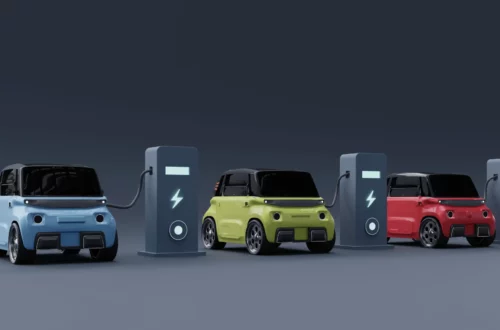Do Electric Cars Have Alternators? Explained!

Have you ever wondered how electric cars, like Teslas, generate electricity without traditional alternators? It’s a common misconception that all cars need alternators to produce power, but electric vehicles operate differently. In this blog, we’re going to debunk the myth surrounding alternators in electric cars and shed light on the fascinating mechanisms behind their power generation.
First, let’s understand the basics. While traditional combustion engine cars rely on alternators to charge their batteries, electric cars use a different approach. Instead of belt-driven alternators, they have electric motors that serve as both the propulsion system and power generator. These motors can convert kinetic energy from the car’s movement into electrical energy, which is then directed towards recharging the battery pack.
In this article, we’ll dive into the specifics of how electric cars generate electricity, providing insights into the nuances of their electrical systems and how they differ from combustion engine cars. We’ll also discuss the advantages of this design, such as increased energy efficiency and reduced dependence on traditional fossil fuel-based engines.
So, if you’ve been curious about how electric vehicles operate without alternators and want to explore the fascinating world of power generation in electric cars, keep reading. We’ll debunk the myth and provide you with a comprehensive understanding of how Teslas and other electric cars utilize alternative methods for generating power.
Introduction to the concept of alternators
In traditional combustion engine cars, alternators play a crucial role in generating electricity. These mechanical devices are driven by the engine’s rotational motion, converting mechanical power into electrical power. Alternators produce an alternating current (AC), which is then rectified to direct current (DC) and used to charge the vehicle’s battery and power various electrical systems.
The primary purpose of alternators is to ensure a continuous supply of electrical energy while the engine is running. They provide power to the car’s electrical components, including the lights, audio systems, and charging ports. Alternators also play a vital role in maintaining the battery’s charge, ensuring it remains at an optimal level for reliable car startup.
By harnessing the rotational energy of the engine, alternators contribute to the overall efficiency of combustion engine cars. Without alternators, these vehicles would rely solely on the battery’s stored energy, which would quickly be depleted.
However, it’s important to note that electric cars, such as Teslas, operate on a different principle and don’t utilize traditional alternators. Instead, they employ innovative technologies to generate electricity. Let’s explore how electric cars generate electricity without employing conventional alternators in the next section.
How electric cars generate electricity
Electric cars have revolutionized the automotive industry by adopting innovative technologies that allow them to generate electricity without relying on traditional alternators. Instead, these vehicles utilize electric motors as generators, harnessing kinetic energy to produce electrical power.
Electric motors as generators
Unlike combustion engine cars, which rely on alternators to generate electricity through mechanical power, electric cars employ electric motors that serve a dual purpose. These motors not only propel the vehicle but also act as generators when the vehicle decelerates or brakes.
Kinetic energy conversion
When an electric car decelerates or brakes, the electric motor switches from consuming electrical energy to functioning as a generator. The mechanical energy created by the car’s motion is converted into electrical energy through the principles of electromagnetic induction. This process involves the rotation of a magnetic field generated by the spinning rotor within the electric motor. As the rotor rotates, it induces an electrical current in the motor’s windings, generating electricity.
Energy flow and battery pack
The electricity generated by the electric motor is then directed to the car’s battery pack, where it is stored for later use. The battery pack serves as the primary power source for various functions within the vehicle, including powering the electric motor during acceleration and providing electricity for the car’s auxiliary systems.
Efficiency and environmental benefits
One of the significant advantages of this electricity generation method is its efficiency. By directly converting kinetic energy into electricity, electric cars minimize energy loss that occurs in traditional combustion engines. This efficiency contributes to increased range and reduced energy consumption.
Moreover, the absence of traditional alternators in electric cars simplifies the overall design and reduces maintenance requirements. Additionally, electric cars produce zero tailpipe emissions, leading to lower environmental impact and contributing to a more sustainable transportation ecosystem.
With advancements in battery technology and electric motor efficiency, electric cars continue to evolve as a viable and eco-friendly option for modern transportation. As the automotive industry embraces these innovations, the generation of electricity in electric cars without traditional alternators is becoming the new norm, redefining how we power our vehicles.
Also read: Can Solar Panels Charge an Electric Car?
Comparing Teslas to traditional combustion engine cars
When it comes to power generation, Teslas and traditional combustion engine cars operate in fundamentally different ways. The innovative technology behind electric cars allows them to generate electricity without the need for traditional alternators. This section will explore the differences between Teslas and combustion engine cars in terms of power generation and highlight the unique features and advantages of electric vehicles.
First and foremost, combustion engine cars rely on alternators to convert mechanical energy from the engine’s rotation into electricity. Alternators are components connected to the engine that generate electrical power to charge the vehicle’s battery and power various electrical systems. In contrast, Teslas don’t incorporate alternators in their design.
Electric cars, including Teslas, generate electricity through their electric motors. These motors act as generators, converting kinetic energy back into electricity during deceleration or when the vehicle is coasting. This process, known as regenerative braking, allows electric cars to utilize the energy that would otherwise be wasted. The converted electricity is then stored in the car’s battery pack and used to power the vehicle’s electrical systems or propel the car forward.
The absence of alternators in Teslas presents several benefits. Firstly, without this mechanical device, the overall complexity of the vehicle is reduced, resulting in a more streamlined and efficient design. Additionally, electric cars, including Teslas, tend to have higher energy efficiency compared to traditional combustion engine vehicles. This is due to the direct power supply from the battery pack to the electric motors, eliminating the inefficiencies associated with converting mechanical energy to electrical energy.
Furthermore, the absence of alternators contributes to the overall environmental friendliness of electric cars. By relying on electricity as their primary power source instead of fossil fuels, electric cars produce zero emissions during operation, reducing their carbon footprint and minimizing air pollution.
Also read: Factors That Influence Total Driving Range of Electric Vehicles
Explaining why Teslas don’t have alternators
In traditional combustion engine cars, alternators play a crucial role in generating electricity by converting mechanical energy from the engine into electrical energy. However, when it comes to Teslas and other electric cars, the concept of alternators is rendered obsolete. Here’s why:
1. Direct power supply from the battery pack: Unlike combustion engine cars that rely on alternators to charge the battery, electric cars have their primary power source in the form of a battery pack. This means that the battery directly supplies power to the vehicle’s electrical system, eliminating the need for an alternator.
2. Efficiency of electric motors: Electric cars utilize electric motors to generate power and propel the vehicle. These motors are not only highly efficient but also capable of acting as generators. When the car decelerates or applies regenerative braking, the electric motor converts kinetic energy into electricity, which is then stored in the battery. This regenerative braking process further reduces the need for an alternator.
3. Simplified power generation system: The absence of alternators in Teslas simplifies the overall power generation system. With direct power supply from the battery and the efficiency of electric motors, electric cars can achieve a more streamlined and efficient energy flow.
4. Environmental benefits: By eliminating the mechanical device of the alternator, electric cars contribute to a greener and more sustainable automotive industry. The reduced complexity and parts involved in power generation not only enhance energy efficiency but also lead to a lower environmental impact.
5. Maintenance advantages: Another advantage of not having alternators is the reduced maintenance required in electric cars. Compared to the intricate systems and moving parts in combustion engine cars, electric cars have fewer components that require regular servicing and replacement, resulting in lower maintenance costs for Tesla owners.
Also read: Increased Energy Efficiency Ultimately Leads to Lower Costs
Benefits and Implications of Not Having Alternators in Teslas
One of the key advantages of electric cars, including Teslas, is the absence of traditional alternators. This absence brings several benefits and implications, contributing to the overall efficiency and simplicity of electric vehicle design.
Reduced Complexity and Maintenance
By eliminating alternators, Teslas experience reduced complexity in their power generation system. Unlike traditional cars, which rely on an alternator to convert mechanical energy from the engine into electricity, Teslas utilize a direct power supply from the battery pack. This streamlined approach eliminates the need for additional components, reducing the chances of mechanical failure and simplifying maintenance requirements.
Environmental Benefits and Energy Efficiency
Another significant advantage of not having alternators in Teslas is the positive environmental impact and increased energy efficiency. Electric cars generate power using electric motors that function as generators during deceleration and braking, a process known as regenerative braking. This feature allows the electric motor to convert kinetic energy into electricity, which is then stored in the vehicle’s battery pack for future use. By utilizing this regenerative braking system and avoiding the energy loss associated with traditional alternators, Teslas can achieve greater overall energy efficiency.
Moreover, the absence of alternators in Teslas contributes to their eco-friendly reputation. By reducing reliance on fossil fuel-based engines, electric cars significantly decrease emissions, contributing to cleaner air and a healthier environment.
Also read: How Renewable Energy is Transforming the Environment: 5 Major Benefits
Future Implications and Advancements in Electric Cars
The world of electric cars is constantly evolving, and there are exciting future implications and advancements that hold the potential to further enhance power generation and efficiency. Let’s take a closer look at what the future holds for electric car technology.
Advanced Battery Technology
One area that holds great promise is the advancement of battery technology. As electric cars become more prevalent, manufacturers are investing heavily in research and development to improve battery capacity and efficiency. This means we can expect longer driving ranges and shorter charging times in the future.
Enhanced Power Generation
Another area of focus is enhancing power generation in electric cars. Current models utilize regenerative braking, which converts kinetic energy into electrical energy to charge the battery. In the future, we may see advancements in this technology that allow for even more efficient energy recapture, maximizing the range of electric cars and reducing the need for frequent charging.
Integration of Solar Power
Solar power integration is also a promising avenue for electric car advancements. By incorporating solar panels into the body of electric cars, vehicles could generate power while driving or parked, further reducing dependency on external charging infrastructure. This would not only increase the range of electric cars but also reduce their environmental impact.
Wireless Charging Technology
Wireless charging technology is another area of development in the electric car industry. In the near future, it may be possible to charge electric cars without plugging them in. This convenience would provide a seamless and hassle-free charging experience, contributing to the widespread adoption of electric vehicles.
Intelligent Energy Management Systems
To optimize power generation and efficiency, the future of electric cars will likely see the implementation of intelligent energy management systems. These systems would intelligently distribute power to various components of the vehicle, ensuring optimal performance while minimizing energy consumption.
As electric cars continue to gain popularity and technological advancements accelerate, the future of electric car technology looks promising. From advanced battery technology to enhanced power generation and intelligent energy management systems, these advancements will significantly improve the power generation and efficiency of electric cars, making them an even more attractive and sustainable option for transportation.
Also read: Renewable Energy vs Fossil Fuels: Which One is Better?
Conclusion
Electric cars, including Teslas, operate without traditional alternators. Instead, they utilize innovative technology to generate electricity. By converting kinetic energy into electricity, the electric motor in an electric car acts as a generator. This eliminates the need for a separate alternator.
The absence of alternators in Teslas brings several benefits. It reduces complexity and maintenance requirements, leading to a more reliable and efficient power generation system. Additionally, electric cars have a positive environmental impact, as they produce zero tailpipe emissions and are more energy-efficient than combustion engine cars.
As the automotive industry continues to evolve, advancements in electric car technology are expected. These advancements will further improve power generation and efficiency, making electric cars even more attractive as a sustainable and eco-friendly option for transportation.





